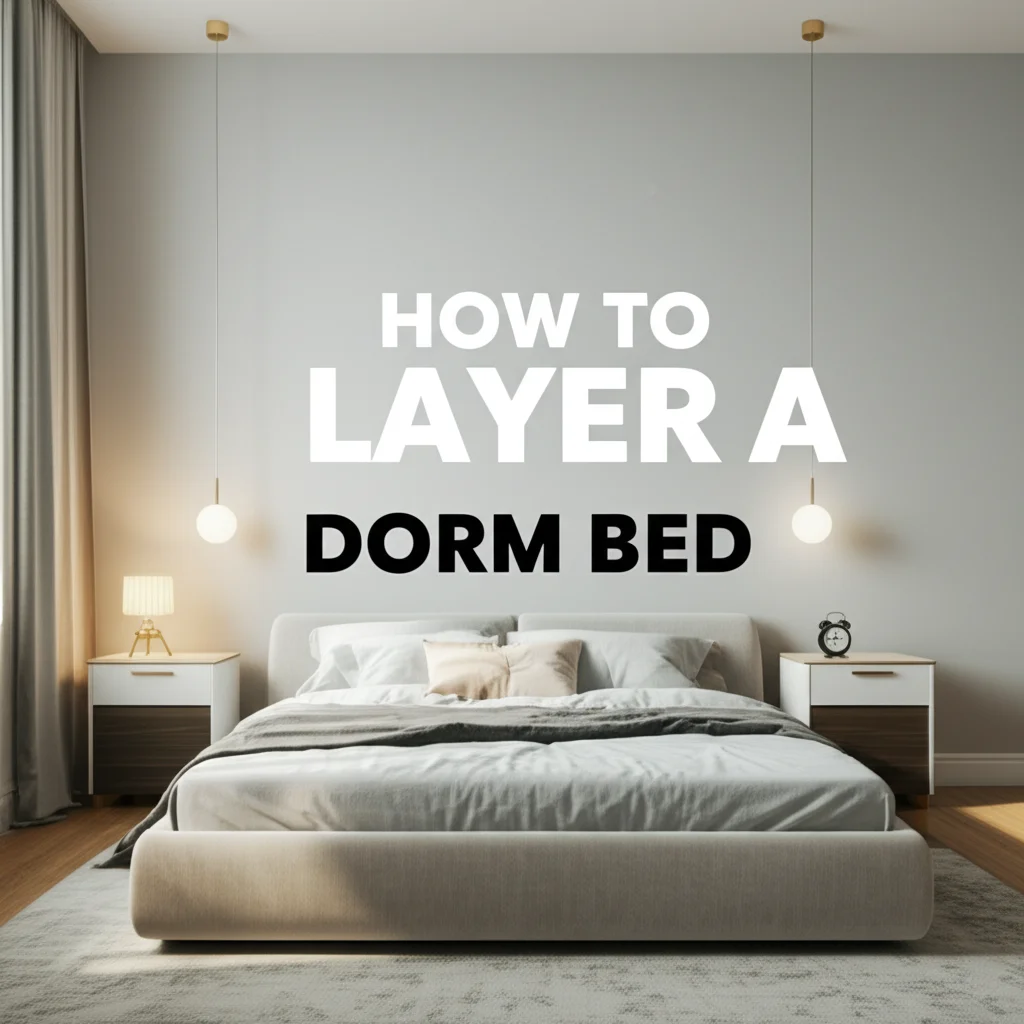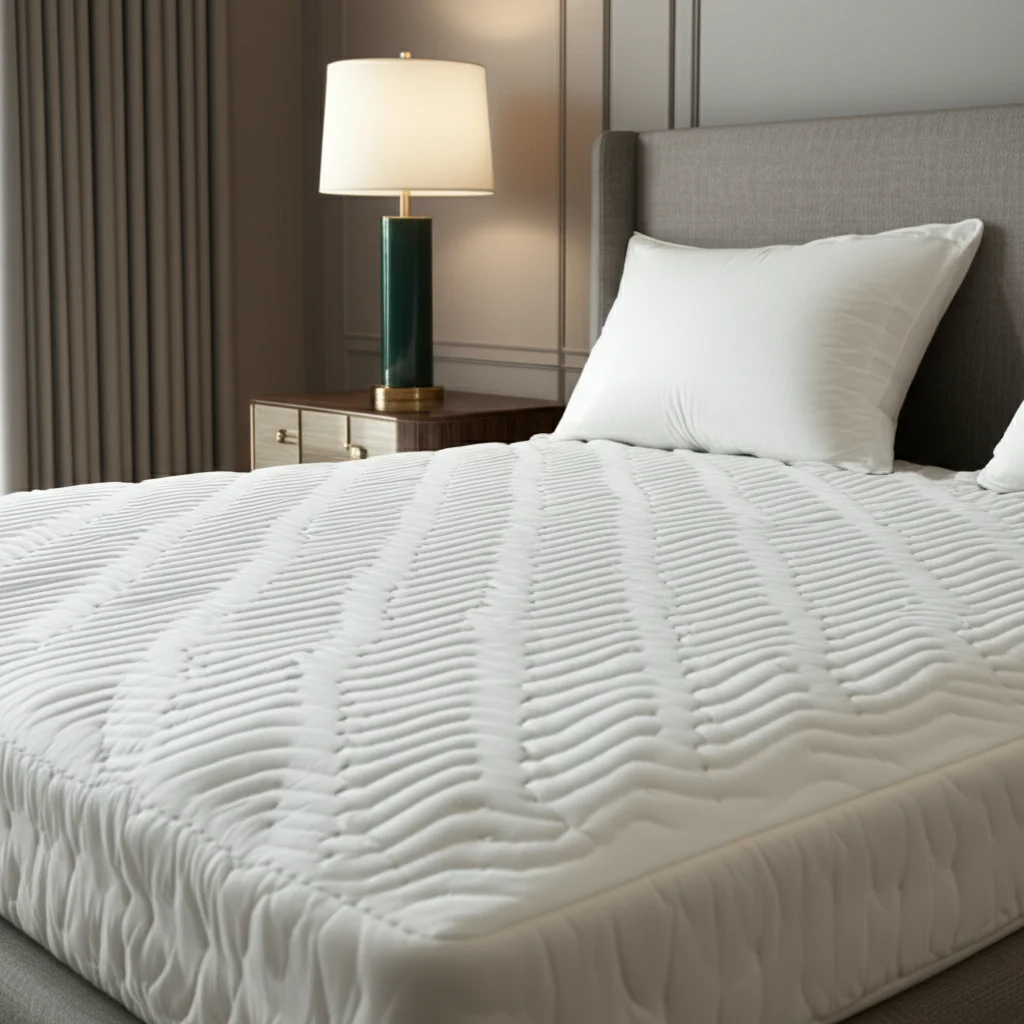· Todd Martin · Home Decor · 16 min read
How To Layer A Dorm Bed

Layering Your Dorm Bed for Ultimate Comfort & Style
Moving into a dorm room presents exciting opportunities. It also means adapting to a new living space. Your dorm bed often serves as a central hub. It is your sleep sanctuary, study spot, and relaxation zone. Learning how to layer a dorm bed correctly transforms this basic furniture. It creates a cozy, functional, and stylish area. A well-layered bed offers maximum comfort and reflects your personality. This guide helps you navigate the process. We will cover every essential step. We help you choose the right items. You will build a perfectly layered dorm bed. This setup enhances your college experience significantly.
Takeaway:
- Prioritize a good mattress topper for comfort.
- Choose durable, soft sheets in the correct Twin XL size.
- Select a comforter or duvet that suits your climate.
- Add blankets and throws for warmth and texture.
- Layer pillows for both support and aesthetic appeal.
- Incorporate practical accessories like bed skirts and caddies.
- Personalize your bed with colors and patterns.
To layer a dorm bed, start with a mattress protector and a comfortable topper. Add a fitted sheet and a flat sheet, ensuring they are Twin XL size. Next, place a comforter or duvet for warmth. Layer throws and additional blankets for texture and adjustable warmth. Finish with sleeping pillows and decorative pillows to create a functional and inviting sleep space.
Building Your Foundation: The Mattress Enhancements
Creating a truly comfortable dorm bed begins with its foundation. Dorm mattresses are often firm, worn, or simply uncomfortable. You can significantly improve your sleep quality with a few smart additions. These initial layers make a huge difference. They provide crucial support and softness. This step is non-negotiable for a pleasant dorm experience.
Mattress Protector: Essential First Layer
A mattress protector is the first item to put on your dorm bed. It serves as a vital barrier. This protector shields your mattress from spills, stains, allergens, and dust mites. Dorm mattresses have a high turnover rate. Protecting yours keeps it clean and extends its life. Look for waterproof and hypoallergenic options. They offer the best protection. You simply slip it over the mattress like a fitted sheet. This layer ensures a hygienic sleep environment.
Mattress Topper: Your Comfort Upgrade
After the protector, add a mattress topper. This is arguably the most important element for comfort. Dorm mattresses often lack plushness. A topper adds a significant layer of softness and pressure relief. You can choose from various materials. Memory foam toppers conform to your body shape. Down or down alternative toppers offer a cloud-like feel. Egg crate foam toppers provide basic cushioning. Select a topper that matches your preferred firmness and support. A good topper can truly make your dorm bed feel like home. This step alone can drastically improve your sleep. You will wake up feeling more rested. Discover how to make your dorm bed more comfortable with a quality topper.
Essential Sheets: The Base of Your Bedding
Once your foundation is comfortable, it is time for the sheets. Choosing the right sheets ensures softness against your skin. They also contribute to temperature regulation. Dorm beds almost always use Twin XL size bedding. Double-check this measurement before buying. Standard Twin sheets will not fit. Picking quality sheets improves your overall sleep experience.
Fitted Sheet: The Snug Cover
The fitted sheet goes directly over your mattress topper. Its elastic edges hug the mattress securely. This keeps the sheet from bunching up or sliding off. Select a fitted sheet with deep pockets if your mattress and topper combined are thick. This ensures a snug fit. High-quality cotton sheets, like Egyptian or Pima cotton, offer breathability and softness. Microfiber sheets are affordable and resistant to wrinkles. Ensure your chosen sheet is durable. It will withstand frequent washing.
Flat Sheet: The Versatile Layer
The flat sheet is placed on top of the fitted sheet. It lies between you and your comforter. This layer provides an extra barrier of comfort. It also makes cleaning easier. You can wash the flat sheet more often than your comforter. The flat sheet adds an extra layer of warmth in cooler months. It can serve as a lightweight cover during warmer periods. You might not need a heavy blanket in summer. Learn how to layer a bed for summer using just a flat sheet.
Pillowcases: Protecting Your Pillows
Pillowcases protect your pillows from oils, dirt, and sweat. They also add a decorative touch. Most sheet sets include matching pillowcases. Consider buying extra pillowcases. This allows for frequent washing. Your face rests on these covers. Keeping them clean is important for skin health. Choose soft, breathable fabrics. Silk or satin pillowcases can be gentle on hair and skin.
Core Warmth: Comforters, Duvets, and Quilts
The main layer of warmth and style for your dorm bed comes from a comforter, duvet, or quilt. This is often the largest and most visually prominent piece of bedding. Your choice depends on your climate, personal preference, and aesthetic goals. It also impacts how warm you will be throughout the year.
Comforters: All-in-One Warmth
A comforter is a pre-filled, stitched blanket. It provides a fixed level of warmth. Comforters come in various thicknesses and fillings. Synthetic fills, like polyester, are hypoallergenic and easy to care for. Down or feather fills offer superior warmth-to-weight ratio. They are also very breathable. Choose a comforter appropriate for your dorm’s temperature control. A medium-weight comforter is versatile for most climates. Comforters are ready to use right out of the package. They require less assembly than duvets.
Duvets and Duvet Covers: Flexible Style
A duvet is a soft, flat bag filled with down, feathers, or synthetic fibers. It requires a separate duvet cover. Duvet covers are removable and washable. This makes them highly practical for dorm life. You can change your duvet cover to update your room’s look. It protects the duvet insert from dirt and wear. This extends the life of your duvet. Duvets offer excellent temperature regulation. You can choose a lighter insert for warmer months. A heavier one suits colder seasons. Explore more about layering blankets on a bed for warmth with a versatile duvet setup. Duvets are a great option for cleanliness and style flexibility.
Quilts: Lightweight and Decorative
Quilts are thinner than comforters or duvets. They often feature intricate stitched patterns. Quilts are ideal for moderate climates or as an extra layer. They add a touch of texture and traditional style. You can use a quilt alone during warmer nights. It can also layer over a comforter for added warmth. Quilts are generally durable and easy to maintain. They provide a unique aesthetic to your dorm bed. Consider a quilt for its decorative appeal. It also offers adaptable warmth.
Adding Layers for Comfort and Style: Blankets & Throws
Beyond your main comforter, additional blankets and throws enhance both comfort and the visual appeal of your dorm bed. These layers provide adaptable warmth. They also introduce varying textures and colors. This makes your bed feel more inviting and complete. They are perfect for adjusting to room temperature changes. You can also snuggle under them while studying or relaxing.
Mid-Weight Blankets: Functional Warmth
A mid-weight blanket sits on top of your comforter or duvet. This layer is perfect for adding warmth on colder nights. It also provides a neat, finished look during the day. Materials like fleece, cotton, or wool are excellent choices. Fleece blankets are soft, lightweight, and warm. Cotton blankets are breathable and easy to wash. Wool blankets offer superior insulation. They are also naturally moisture-wicking. Choose a color or pattern that complements your main bedding. This adds depth to your layered look.
Throw Blankets: Decorative and Cozy
Throw blankets are smaller, decorative blankets. You drape them casually over the foot of your bed or a corner. They add a touch of color, texture, and personality. Throws are perfect for quick warmth during studying or lounging. They are easy to grab when you need a little extra coziness. Look for interesting textures. Chunky knits, faux fur, or woven patterns work well. A throw blanket makes your bed look more inviting. It also adds a pop of style. Learn how to put a throw on a bed to instantly elevate your dorm decor. You can even decorate a bed with a throw for a designer touch.
The Pillow Power-Up: Support and Decoration
Pillows are crucial for a good night’s sleep. They also play a major role in how your dorm bed looks. Layering pillows creates a plush, inviting headboard effect. It offers ample support for different activities. Think about both function and aesthetics when choosing your pillows.
Sleeping Pillows: Your Nightly Support
Start with one or two high-quality sleeping pillows. These provide essential neck and head support. Your preferred sleeping position guides your pillow choice. Side sleepers often need firmer, thicker pillows. Back sleepers benefit from medium-firm pillows. Stomach sleepers usually prefer softer, flatter pillows. Ensure your sleeping pillows have good loft and support. This helps maintain proper spinal alignment. Investing in good sleeping pillows is key for restful sleep. Use pillow protectors under your pillowcases. They extend pillow life.
Euro Pillows: Architectural Backing
Euro pillows are large, square pillows. They typically measure 26x26 inches. They sit upright against the wall or headboard. These pillows provide a substantial backdrop for your standard sleeping pillows. They add height and structure to your bed design. Euro pillows are also excellent for back support when sitting up. You can read, study, or watch movies comfortably. Use decorative Euro shams to cover them. This ties into your room’s color scheme.
Decorative Pillows: Personality and Flair
Decorative pillows, also known as accent pillows, are the final touch. They add bursts of color, texture, and pattern. These pillows are purely for aesthetic appeal. You can choose different shapes and sizes. Lumbar pillows offer lower back support when sitting. Small square pillows add visual interest. Select covers that reflect your personal style. They can introduce contrasting textures like velvet, faux fur, or embroidery. These pillows transform a plain bed into a stylish focal point. Avoid too many decorative pillows. They can quickly clutter a small dorm bed. A few well-chosen ones make a big impact.
Smart Storage and Practical Accessories
Maximizing space is crucial in a dorm room. Your bed can become a hub of organization. Integrating smart storage solutions and practical accessories makes your layered dorm bed even more functional. These additions enhance daily convenience. They help keep your small space tidy.
Bed Risers: Creating Under-Bed Storage
Dorm beds often have limited clearance underneath. Bed risers elevate your bed frame by several inches. This simple addition creates valuable storage space. You can slide storage bins, suitcases, or extra linens under your bed. This frees up closet and desk space. Choose sturdy risers with a wide base for stability. Some risers even come with built-in power outlets. This is a bonus for charging devices. Utilize every inch of vertical space. It makes a significant difference in a compact dorm room.
Bedside Caddies and Organizers
A bedside caddy or organizer hooks over the side of your bed. It hangs down, providing pockets for essentials. Store your phone, remote, glasses, books, or snacks within easy reach. This keeps your nightstand clear or eliminates the need for one. It is especially useful for lofted or bunk beds. You can access items without getting out of bed. These caddies are a simple yet effective way to declutter your sleeping area. They make your layered dorm bed even more convenient.
Under-Bed Storage Bins
Once your bed is elevated, invest in slim, roll-out storage bins. These containers fit perfectly under the bed. Use them for seasonal clothes, extra bedding, or bulky items. Clear bins allow you to see contents easily. Fabric bins offer a softer look. They keep dust off your belongings. Maximizing under-bed storage is key for small dorm rooms. It helps maintain an organized and functional living space.
Headboards and Backrests
While not strictly layering, a headboard or backrest can complete your dorm bed setup. A clip-on headboard offers a more finished look. A wedge pillow or backrest pillow provides comfortable support for sitting up. These items transform your bed from just a sleeping spot. They make it a comfortable lounge area. Consider how to attach a headboard to a dorm bed for added structure and style.
Personalizing Your Dorm Bed: Color, Texture, and Theme
Your dorm bed is a canvas for self-expression. Personalizing it makes your space truly feel like home. Thoughtful choices in color, texture, and theme create a cohesive look. They reflect your unique personality. This final step transforms your layered bed into a stylish sanctuary.
Choosing Your Color Palette
Start with a base color for your sheets and main comforter. Neutrals like white, grey, or beige provide a calm foundation. You can then add pops of color with throws and decorative pillows. Alternatively, choose a vibrant main color. Complement it with calmer accents. Consider colors that evoke certain moods. Blues and greens are calming. Yellows and oranges are energizing. Your color palette should align with your personal preferences. It should also harmonize with other elements in your room.
Incorporating Varied Textures
Texture adds depth and interest to your bed. Mix and match different fabrics. Combine smooth cotton sheets with a cozy fleece blanket. Add a chunky knit throw or a faux fur pillow. Velvet shams provide a luxurious feel. Linen offers a relaxed, breathable vibe. Layering textures creates a multi-dimensional look. It makes your bed more inviting to touch. Texture prevents your bed from looking flat or one-dimensional. It enhances the sensory experience of your sleep space.
Developing a Personal Theme
Think about a theme or overall aesthetic for your dorm bed. Do you prefer a minimalist look? Stick to clean lines and muted colors. Are you drawn to bohemian vibes? Incorporate natural materials, patterns, and earthy tones. Maybe a classic, preppy style suits you. Use stripes, plaids, and solid colors. Your theme can draw inspiration from your hobbies, favorite places, or art. Consistency in your theme creates a harmonious and visually appealing bed. Learn how to create the most comfortable bed by harmonizing all elements.
Adding Personal Touches
Beyond bedding, small personal touches make a big difference. Add a string of fairy lights around your headboard. This creates a cozy ambiance. Display photos of friends and family. Incorporate small plants or unique decorative items. A soft rug next to your bed adds warmth underfoot. These details complete your personalized dorm oasis. They make your dorm room feel more like a true home away from home.
Maintaining Your Layered Dorm Bed
Maintaining your layered dorm bed ensures its longevity and hygiene. Regular cleaning keeps your sleep space fresh and inviting. Proper care extends the life of your bedding. It also promotes a healthy environment. A clean bed contributes to better sleep quality.
Regular Washing Schedule
Establish a routine for washing your bedding. Wash pillowcases and flat sheets weekly. Fitted sheets and duvet covers can be washed every two weeks. Comforters and duvets need cleaning less often, perhaps once a season or every few months. Always follow the care instructions on each item’s label. Using the correct water temperature and detergent prevents damage. Refer to guidelines on how to clean bed sheets for best practices. Regular washing removes dust, sweat, and allergens.
Spot Cleaning and Airing Out
Address spills or stains immediately with spot cleaning. Use a mild detergent and a damp cloth. This prevents stains from setting. Air out your comforter or duvet periodically. Hang it outside on a sunny day if possible. This helps refresh the fabric. It removes any lingering odors. Airing also helps to fluff up down or synthetic fills.
Protecting Your Bedding
Use mattress and pillow protectors. These barriers prevent moisture and allergens from reaching your core bedding. They are much easier to wash than mattresses or pillows. Consider rotating your mattress topper regularly. This ensures even wear and prolongs its effectiveness. Store seasonal bedding in breathable bags. Keep them in a dry, clean area. This protects them from dust and mildew. Proper protection reduces the need for deep cleaning. It extends the life of your entire layered setup.
Managing Layers for Cleanliness
Consider removable and washable layers. Duvet covers are excellent for this reason. You can wash the cover without washing the entire duvet. Use a flat sheet to create a barrier between you and the comforter. This keeps your comforter cleaner for longer. The more washable layers you have, the easier it is to maintain hygiene. This approach saves time and effort. It keeps your dorm bed feeling fresh.
FAQ Section
Q1: What is the most important item for a comfortable dorm bed? A: The most important item for a comfortable dorm bed is a high-quality mattress topper. Dorm mattresses are often basic. A good topper significantly improves softness and support. It transforms the sleeping experience. This layer provides crucial cushioning. It helps you get restful sleep.
Q2: Do I need Twin XL sheets for a dorm bed? A: Yes, almost all dorm beds require Twin XL size sheets. A standard Twin sheet will be too short. Always check the bed dimensions. Twin XL sheets are five inches longer than regular Twin sheets. They ensure a proper fit.
Q3: How many pillows should I have on a dorm bed? A: You should aim for at least two sleeping pillows for support. Add one or two Euro pillows for a backrest. One or two decorative pillows can complete the look. This combination provides both comfort and style. It also offers versatility for sitting up.
Q4: How can I add storage to my small dorm bed space? A: To add storage, use bed risers to elevate your bed. This creates under-bed space for storage bins. A bedside caddy is also excellent. It keeps small essentials organized and within reach. These solutions maximize vertical and horizontal space.
Q5: What’s the difference between a comforter and a duvet for dorms? A: A comforter is a single, pre-filled, stitched blanket. A duvet is an insert that requires a separate, removable cover. For dorms, duvets with washable covers offer more flexibility. You can easily clean the cover. You can also change its style often.
Q6: How often should I wash my dorm bedding? A: Wash pillowcases and flat sheets weekly. Fitted sheets and duvet covers can be washed every two weeks. Comforters and duvets need less frequent washing, perhaps seasonally. Regular washing maintains hygiene. It keeps your bed fresh.
Conclusion
Layering a dorm bed transforms a simple piece of furniture. It creates a personalized, comfortable, and functional haven. We started with essential mattress enhancements. We then moved to core bedding layers. We also explored decorative and practical additions. Each step builds upon the last. You now have the tools to create your ideal student sleep space. Remember to choose Twin XL sizes for most items. Prioritize comfort with a quality mattress topper. Add warmth and style with comforters, duvets, and blankets. Don’t forget the power of layered pillows. Incorporate smart storage solutions for small spaces. Finally, infuse your personality through color, texture, and thoughtful accessories. By carefully selecting each element, you will master how to layer a dorm bed. This effort leads to better sleep. It also creates a more enjoyable college experience. Make your dorm bed a true sanctuary. You deserve a great place to rest and recharge.





